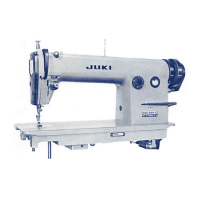VII.
MALFUNCTIONS
AND
CORRECTIVE
MEASURES
Malfunctions
Causes
Order
of
Inspection
and
Corrective
Measures
A. l-scvcral stitches skip at
start
of
sewing
1.
Thread
remaining at the
needle
eye
after
thread
trimming
is too
short
* Needle eye passing is defective. Tension
of
needle thread
at trimming time may be too strong.
' Tension of first tension disc too strong
* Floating of second tension disc at trimming time inadequate
* Timing
of
cam
too
fast
* Position of hook presser wrong, causing needle thread to
slip
off
at trimming time
* Fixed knife placed too close to needle. Blade point is
sticking
out
too
far
* Knife thread guide, moving knife and sewing hook are
bruised
'D
Inspect
the
needle
thread
route,
correct
idle
spinning
of
thread
from
thread
guide
rod
and
position
of
thread
guide
of
the thread stand.
® Rotate the thread adjusting nut of the first
tension
disc to left and
weaken
the
tension.
(D Check and see if the floating range of the second tension disc is 0.5mm~lmm
(l/64"~3/64") when the bobbin
presser
is
pushed
in to right and adjust by the
adjusting
nut
under
the bed
(Refer
iV-4).
Also see if
the
disc is loosened evenly, horizontally, and if not, cither rotate
the tension spring 180° or change the slant of the spring.
(4)
FollowIV-1 and adjust cam
timing.
(D
Inspect
the loosecondition of
bobbin
thread
presser
set
screw
(IV 7).
(6) Remove the needle plate, inspect the position of the fixed knife and adjust any
bruise
of
moving knife
(lV-3,
lV-6).
(T)
Inspect the bruised condition of the sewing hook and knife thread guide hole.
If any bruises are found, thoroughly polish with buff, etc. If the bruises are
serious, change
the
parts.
2. The needle, needle plate
and
presser
foot
used
are
inadequate
or the
pressing power is
too
weak
* The
"a"
dimension is too large
The
"b"
groove is too large
So the sewn needle thread cannot be pressed down
* Needle is too large
* Needle hole of needle plate too large
* Groove of "A" part of needle hole of needle plate too long
* Pressing
power
too
weak
(T)
Inspect the shaping of "a" and
"b"
part of presser foot and "A" part of needle
plate.
a. When using
synthetic
thread
on
tricot
material.
a <
0.8mm
b & A
part
r <
0.3mm
b. When synthetic thread is used, a 1.2mm, b & A
part
without grooves.
c. For
cotton
thread
too,
as long as no defective thread tightening, a, b, A parts
should
have
small
grooves.
d. The finer the cloth, more mesh the cloth, the more slippery the thread, the
smaller the stitch pitch, the grooves of a, b, A parts should be small.
® As long as the thread tightening is not defective, use a finer needle.
Use
#7
#9
needles especially for
tricot
material
(3) If pressing power is too weak, adjust by the presser foot adjusting screw.
3. Hook point does not scoop
up
the
needle
thread
(skip-stitching)
' Bad timing of needle with sewing hook - too much clearance
' Blade
point
of
hook
is
abraded
*
Inadequate
installation
of
needle
(f) Run the
machine
at low speed and if skip-stitch is
verified,
correct the
angle
of
the
needle
and
its
curvature.
® Try
decreasing
the spring power of the take-up springand its range of movement
to
5~7mm(3/16~l/4").
<D
Make the timing of hook faster than normal lockstitchingmachine.
Make clearance less
than
0.0Smm(l/S12").
4.
The
bobbin
thread
is
too
short
at the start of sewing
' The bobbin thread tip is pulled in inside the bobbin case
by
the
idle spinning
of
bobbin.
a. Inadequate pressingpressureof bobbin presser.
b.
Bobbin
thread
tension
is
too
weak
* Fither the bobbin thread tension is too strong or the hook
is
bruised
and
the
bobbin
thread
is
cut
short
(D After the thread is trimmed, take out the bobbin caseand if the idlespinningof the
bobbin
is
too
much:
a. Make the pressure of the bobbin presser stronger. (Refer to IV 7).
b.
Check
the
tension
of
the
bobbin
thread.
Conduct the above inspection and make the length of the bobbin thread to
35^
50mm(l-3/8~l-31/32").
(D After the thread is
trimmed,
if there is no idle
spinning
of the bobbinand the thread
is trimmed short, make the pressure of the bobbin presser weaker.(Refer to IV 7).
®
Polisli
the sewinghook or exchangeit.
B. Needle thread slips
out
from
the
needle
at
the
start
of
sewing
5. The length
of
needle
thread
after
trimming is
scattered
* The timing of the cam is too slow, thus first thread
tension disc becomes too strong and the thread is cut
before the blades of the moving knife and the fixed knife
interlock
each
other.
(So-called intermediate cutting)
• Penetration of
hook
presser into the bobbin case is too
shallow, thus the needle thread slips off from the hook
presser
(D Stop the motor and at the
position
where
the
needle
is
lowered,
insert
the hook
presser into the bobbin case. Rotate the hand wheel with your hand, trim the
thread and stop the machine at the upper dead point. At this instant if the needle
thread
remaining
at the tip of the needle eye is more than 10mm(3/8") shorter
than
when
trimmed
by
pedal
action,
this
means
a "intermediate"
cutting.
a. So, quicken the cam timing and weaken the first thread tension.
b. Sharpen the fixed knife again correctly.
(IV-5).
c.
Polish
the knifethread
guide,
moving
knifeand the
sewing
hook
thoroughly.
28

